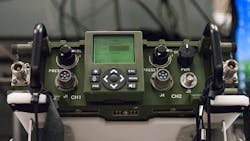Second MUOS-Satellite Radio Test Lab Begins Operations
General Dynamics C4 Systems opened the doors to a new radio testing laboratory for the Mobile User Objective System (MUOS) satellite-ground station communications that make up the soldier’s network. MUOS ultra-high-frequency (UHF) satellites aim to provide more secure military communications by leveraging commercial cellphone waveform technology. By adapting the wideband code-division multiple-access (WCDMA) architecture, the satellites can provide 16 times greater capacity than current UHF satellites.
Located in Scottsdale, Ariz., the U.S. Navy-approved laboratory is one of two that supports testing for radio terminals that will connect with the MUOS space-ground network. The lab is equipped with hardware and software that simulates radio connectivity with the network. Radios are provisioned with the WCDMA-based, MUOS-specific waveform to make secure voice calls and complete data transmissions at different data rates across the network. Communications flow to the satellites via UHF WCDMA links; the satellites relay the data via a Ka-band feeder link to one of four interconnected ground sites.
Watch a video from General Dynamics C4 Systems below for more on the soldier’s network:
The lab will help the U.S. military and government find cost-effective and efficient ways to add MUOS-capable radios, such as Rockwell Collins’ ARC-210 and General Dynamics’ AN/PRC-155, to current communications networks. Recently, a team from Harris connected the AN/PRC-117G Falcon III radio to a MUOS system developed by Lockheed Martin. According to Lockheed Martin, over 55,000 currently fielded terminals could be upgraded for full MUOS capability by 2016.
The narrowband capability delivered through MUOS ensures reliable coverage even during tumultuous situations such as national emergencies, disasters, and humanitarian relief. Once fully deployed, the MUOS constellation will consist of four geosynchronous satellites—plus an on-orbit spare—as well as the four ground stations. The constellation is expected to achieve full operational capability in 2015.
About the Author
Iliza Sokol
Associate Digital Editor
Iliza joined the Penton Media group in 2013 after graduating from the Fashion Institute of Technology with a BS in Advertising and Marketing Communications. Prior to joining the staff, she worked at NYLON Magazine and a ghostwriting firm based in New York.
